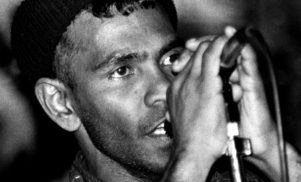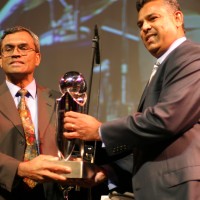BY DAVID KATZ
Fronted by an intense singer with an oblique songbook and a mysterious past, Glorious Din were unlike any other group to emerge from San Francisco’s ‘80s underground. David Katz tells the story of Eric Cope, the chosen persona of a Joy Division-obsessed Sri Lankan boy who travelled halfway around the world to follow his punk dream.
The early 1980s was an incredibly fertile time for underground music in San Francisco. The scene was centred on a troop of interconnected bands playing at alternative spaces to small but devoted audiences – an antithesis to the stadium status achieved by the local rock acts of the ‘60s and ‘70s.
The multifaceted nature of the ‘80s scene – encompassing everything from three-chord thrash punk to garage-band pop, experimental art rock and atonal noise, all created by bands with overlapping memberships – can seem baffling to outsiders. Of the many acts clamouring for attention, Glorious Din was perhaps the best, their mesmerising sound instantly getting under the skin via their non-standard drum patterns, eastern-sounding guitar melodies, a melodic bass in pole position, and a dissociative foreign singer who intoned prophetic poems in a trance.
The enigmatic group acted as a catalyst too, helping total unknowns to gain recognition and being the uncommon glue linking Faith No More, the Dead Kennedys and Michael Franti, as well as REM and the Cocteau Twins, such is the reach of their influence.
The tech giants of Silicon Valley have since turned San Francisco into a boutique yuppie playground, but the city was a transient place back then, characterised by low rent, cheap drugs, and radical social activism. Its overarching permissiveness made it a haven for misfits and dropouts rather than microchip prospectors brokering the latest dating app. The music of the ‘80s counterculture thrived in peripheral spaces, and part of Glorious Din’s appeal was their mysteriousness: a quartet of mismatched musicians not necessarily playing their chosen instruments, with the obscure lyrics of their intense frontman near impossible to decipher. The group imploded after only three years, but their cult appeal has lasted far longer through their two albums and related material on their Insight label.
Tracing the band’s backstory is no easy feat, since the lead singer and chief shape-shifter, Eric Cope, is central to the tale. Back in his native Sri Lanka, Eric was a barefoot boy with a Sinhalese name, born after the appearance of strange omens: a solar eclipse, the unexpected arrival of a helicopter, and a sleeping cobra on a train. His mother knew he would be different from everybody else and that he would have a gift to give, and her belief had a big impact on him.
The young boy grew up with wild animals and birds all around him in the dry zone jungle of Polonnaruwa, in the North Central Province of Sri Lanka. The most important influence in his life then was the local shaman, Appu Hamy, who became his mentor, telling him Buddhist Jataka stories and other folk tales, and teaching him pal kavi chants while collecting the bones of animals that had been devoured by leopards in the night.
Tin Tin comics were another early source of inspiration, and his mother played local music on the radio continuously. But everything changed when he was eight years old and his family moved to the urban environment of Galkissa, a beach town outside Colombo.
“When my parents moved to the city, I felt like a noose was around my neck, and I felt it get tighter and tighter,” he recalls. “I was not in the jungle, so there was something missing in my life, and getting into trouble, and comics, was how I filled that empty space. By the time I was 15 I was a seasoned thief, moving in and out of crowded markets and stores, stealing whatever I could, but I mostly stole books and comics. And the thief was born because of the destruction that happened to me after my parents moved to the city. I was alone, an out-of-place outsider, so I would just move about in the street to see what I could steal. I didn’t want to get into trouble, but I did.”
Soon he would endure school suspensions and a jail term. “In 10th grade, when I was 15, I was getting another beating by a priest, who later became the rector of the school. I had enough of all that, so I got a hold of the cane, broke it in two, and hit him back. He fell and hurt himself, and I got suspended from school for three weeks. Then, a few months later, I was riding a bus and hadn’t paid the fare, and I got caught. The conductor was trying to take me to the police station, so I hit the conductor with his ticket machine. I went to jail for this, and got expelled from school.”
After his release, he worked as a gravedigger and then in a fiberglass boat factory. A visit to a village ‘dentist’ resulted in the loss of eight teeth in a near-death experience. He encountered Bob Dylan in the 1972 Concert for Bangladesh film, about the benefit gigs put on by George Harrison and Ravi Shankar, which inspired him to buy a guitar and become a folk singer. Nicolas Roeg’s Walkabout, the 1971 film about siblings left to fend for themselves in the Australian outback, also had a profound effect on him. And crucially to the next stage in his story, his family hosted a 16-year-old girl from Bettendorf, Iowa, for a few months; he made music with her too.
At 19 years old, with a strange working class English accent picked up from John Peter Jones’ Brixton-set book The Feather Pluckers, he travelled to the emirate of Sharjah where he worked in a pet shop run by a Palestinian. The conditions were exploitative; his employer retained his passport, making him work 14-hour days under the threat of deportation, and after three weeks he lashed out at his boss and fled. Thankfully, a friend who worked as a cook on a Greek ship got him a job as a ‘house boy’ for some Dutch construction workers lodging at a local guest house. “The Dutch people loved me,” he says. “They were only a year or two older than me, and we all liked the same music – a lot of early punk, Elvis Costello, Joe Jackson, and the Eagles, Beach Boys and the Supremes.”
His Dutch companions subsequently arranged for him to get a visa, sponsoring him to go to Holland for a time. There, he wrote to the exchange student from Iowa who had stayed with his family in Sri Lanka, saying that he wanted to come to America. Her parents made arrangements for him to travel there, where he attended a local chiropractic school and soon met a young woman named Jessica Lea. Although she was already pregnant with another man’s child, they quickly married.
“When our boy Bruce was three months old, we went to Philadelphia,” he continues. “I was going to go there and start a punk band, and we lived in a $5 hotel in the poorest section of Philadelphia for four or five months, and when our money ran out Jessica Lea’s sister and her husband rescued us—they sent us two airline tickets to Alaska, so we lived in their trailer in Big Lake where they were homesteading. Then Jessica Lea got a job as a hotel maid in Anchorage, so we moved to Anchorage and I got a job in the planning department as a graphic tech. I mostly drew maps and delivered them to the clients.”
“The name White Front was Eric’s idea, because he thought it sounded racist and fascist and would get attention because he was black,” explains Heeschen, the Davenport native who would later play bass in Glorious Din. “They wanted to play the Clash, Dead Kennedys, Black Flag, the Dead Boys—anything loud, fast and bratty. They teamed up with Craig Caldwell, a high school kid, and Eric Larson, a former professional cyclist with a troubled family history.
I was the only one who could actually play an instrument, but we found a sound that worked enough to get some basement shows, and a show at the local gay bar. We practiced in Eric Cope’s rented house in the east side of town, and the cops came to shut us down pretty often in the summer when the neighbours had their windows open. The Unitarian Church in Iowa City was a focal point for punks in eastern Iowa, because it was in a college town, but they only let us play once we convinced them Eric was the singer, and they wouldn’t let us put the name on the poster for the show.”
Heeschen was raised among the suburban cornfields and joined a rock covers band as a high school student, but switched focus after being exposed to the Sex Pistols and the Ramones in 1978. Instead of taking up his probationary placement at MIT, he decided to pursue music, and says that Cope made an immediate impression. “When I first met Eric Cope, I thought he was on the verge of exploding. He had a wide smile, and when he got excited he would almost shake. He also had a dark side that came out after a beer or two, and we were always watchful to make sure he didn’t start any trouble that would get him locked up or killed. He was impatient, smart, philosophical, and driven to music to a ridiculous degree. I was impressed about how little he cared about anything else—music was everything.”
Within a year White Front had been banned from every local venue, so they decamped to San Francisco in August 1982 at the suggestion of Tim Tonooka, publisher of Ripper magazine. Their drummer stayed behind in Iowa, so a Rough Trade ad brought in Bay Area native Pete Herstedt, who had played guitar in Santa Barbara punk band the Generators and was also competent on drums. “Pete was a solid drummer with a simplistic style that worked well for us,” says Heeschen, “but he was mysterious and never let us know where he lived or worked. He was trying to keep his home life separate from his band life, so it took years to figure out even simple details about him.”
Local venues were wary of hosting White Front because of their name, and artistic disagreements cause a rupture in January 1983. “Eric was listening to a lot of Joy Division and Killing Joke, and he wanted to move the sound that way, while Tim wanted things faster,” says Heeschen. “So when we wrote songs it was half of one kind and half of another.” Storm, Heeschen and Herstedt splintered to form the garage-rock Koel Family, and Cope and bassist Eric Larsen started the psychedelic Other Voices, which soon split. Cope then began playing with guitarist Jay Paget, who’d left his native Boston to study journalism at the University of Oregon, only to spend a couple of years hitchhiking all over the West.
“I wanted to get as far away from Boston I could get, physically and culturally,” remembers Paget. “So after a final drunken night in Boston going to a Marshall Tucker concert with my friends, I flew to the West Coast. I can still recall my first glimpse of Eugene and the sinking feeling that accompanied it as I stepped out of the airport into the grey skies and the air filled with the smell of the paper mills of the Pacific Northwest. I didn’t know anyone in Eugene so I spent a lot of time teaching myself to play guitar – just before I left home I grabbed my brother’s guitar, without asking him. At the time, my musical influences were holdovers from high school and FM radio, like Springsteen and Billy Joel. I lasted only a couple semesters at the University of Oregon. I had met a bunch of freaks who were very entertaining and none of them in school, and I willingly followed their lead to places I later thought I never would have gone if I had only known.
“After a couple years I struck out on the road hitchhiking with absolutely no plan other than seeing where things would take me. I would stay in towns for a few months, work a bit, then head back out on the road. I either gave away or sold everything I owned. A woman from Davis, California, gave me a white Ovation guitar that I would tout around and play while waiting for rides. I was not listening to the radio and did not have much of a sense of what was happening musically.
Being on the road was a choice, so I can’t really say I was homeless, but I must say I fully removed all of the usual safety nets like a home, money and a circle of friends to rely on. I landed in San Francisco in 1982—the proverbial end of the road. I was tired and wanted something different, all my belongings could fit into a Converse gym bag. I had tricked with a guy named Max who was happy to put me up until I could get a job. I made a few friends in town and eventually the circle widened to the point where I met folks in a band named Radio Free. They introduced me to the Mab and Club 181 in the Tenderloin, which looked like a cross between a gangster bar and a bordello.”
Paget says his alliance with Cope was almost a non-starter. “I put up an ad on the Rough Trade bulletin board looking for other musicians and got a call from a guy who said he was a singer. At the time, I really didn’t want to be talking to a singer, and I remember my initial thought was to hang up. But the guy sounded sincere, so I made arrangements to meet. I immediately liked his songs and his singing—partly due to his accent, partly due to his lean note choices—and the songs were simple enough to add accompaniment. My impression was that he was singing songs that meant something to him, but it was hard to decipher, maybe because English was a second language.”
“When I write a song, it’s not like I search my head,” Cope explains. “Songs just happen. And only after it’s done I see what that song is about, or who the song is about. A song, a photograph, a drawing—I always like it to surprise me. See, in Sri Lanka we don’t give too much importance towards thoughts, we feel more. So when I wrote all the songs I never thought about what they were about. Even now, some of the songs, I don’t know what I’m singing about. It was a feeling. When I write songs, I like how the words look, how the lines look on paper, the images the words create. With Glorious Din, it was all feeling, it had nothing to do with the mind.”
“He was very positive in his encouragement of my guitar accompaniment, which quickly took the form of single-note repetitive patterns played over the chord changes,” Paget continues. “Given my lack of skill, this was pretty much my only option other than mimicking the chords he was playing, which seemed pointless. My limitations defined the style and I suppose my renegade psychotic spiritual friends who had introduced me to Indian ragas helped to also define the eastern sound of the note playing.”
“Glorious Din’s North African sound, the guitar parts Jay is playing in a lot of our songs, that comes from what I learned when I was in the Middle East from this boy Dubaku Naru, who was from Egypt,” says Cope. “I would be with Dubaku Naru real late, sometimes till morning, sitting on the ground outside in front of the fire. He would be playing song after song and then he would try to teach me the songs, though I was real slow to learn. When I first started to write songs with Jay, he used to just play the chords I played, and that wasn’t what I wanted to hear. I told him what I wanted in my songs was just a skeletal, spare sound, just a few repetitious notes. And that is what he started to do.”
“In the next couple months we had written enough material to think about getting others to join in,” Paget continues, “so Eric called an Iowan bass player, Matt Hall. We rented a rehearsal room in Hunters Point with another band that had just changed their name from Faith. No Man to Faith. No More. Our three-piece was comprised of Eric singing while playing the stand-up drums, Matt on bass, and myself on guitar and vocals. At one point Matt said, ‘That last song sounded like a glorious din,’ and we immediately decided that was our name.”
“I was living in the Fillmore district with my wife and my two boys, but one day I came home and she was gone with my two boys,” says Cope. “Breaking up with my wife and losing my boys affected me deeply. It got me walking down a very dark and lonely street. I called Matt, who was still in Iowa City, and told him to come to San Francisco, that he can live at my apartment. The next thing you know he is here knocking on my door with two skinheads, Nick Volm and Marty, and one of their girlfriends. Right away Matt started to play bass with me and Jay and I got Marty to play drums. Around that time we got the studio at Hunters Point. Marty didn’t last long—he went back to Iowa—then I started playing drums and singing. We had about 15 songs then.”
Glorious Din cut a demo tape, Silence, in December 1983 and had a gig lined up in February at the infamous Mabuhay Gardens. Cope asked Faith No More to take the headlining spot, despite it being only their third-ever performance. But then Matt Hall unexpectedly moved back to Iowa, so Cope asked Doug Heeschen to join Glorious Din as a temporary replacement, with Pete Herstedt to accompany on drums. The debut show immediately marked them out as different, with the skinny Cope standing stock-still at the microphone, murmuring his unknowable lyrics from another place. “When I sing, I could be on stage or I could be alone in my room, I enter another world,” Cope explains. “I’m not there. I just go into the song—the memory of the song.”
The musical backdrop was equally striking, with Paget’s eastern-sounding guitar lines striking the pace, which left space for Heeschen’s meaty bass to provide the main melodies over atypical drum patterns from Herstedt. Minor keys dominated, and everything was moody and contemplative, signalling loss and abandoned dreams, yet also the notion of freedom. And on the few songs that Paget sang, Cope would play tribal rhythms on a single floor tom, mounted on a stand beside his microphone. You could hear the Joy Division influence in Cope’s vocals, but the sound the band conjured was definitely their own.
“In general, we played faster and shorter songs in the early days,” says Heeschen. “Our music evolved quickly and constantly and we never played the same set twice. Writing songs was difficult because Jay’s parts were usually just a smattering of notes at the beginning. He’d tap his foot at the tempo he wanted to play and just keep playing until Pete found a way to put a simple beat behind it. The idea of playing in measures and time signatures was just not in the program for Jay, so it was up to Pete and me to find a pattern to link the notes together. Towards the end, Jay was writing in a more straightforward method, but the early songwriting experiences were difficult and frustrating. What kept us at it was Eric’s drive and Jay’s creativity, and the feeling that the music was infused with some kind of magic. I am an atheist through and through, but there was something going on in there that we did not control.”
“When [Heeschen and Herstedt] joined, I noticed Eric had specific directions for them that had not been part of our song making before,” says Paget, “things like a directive for Pete to never hit the cymbals.”
“Eric was a prolific songwriter but wasn’t much of a musician. I think he needed the rest of us to put meat on the bones of his ideas, so to speak,” adds Herstedt. “While Glorious Din had a very collaborative approach to creating our music, there was certainly a hierarchy, and Eric was the leader. This was a change for me, as I had been used to taking charge as the guitarist and primary songwriter in previous bands. But Eric encouraged me to develop a fairly unconventional approach. He definitely wanted me to stay off the cymbals and focus more on the tom toms, but didn’t provide specific direction other than that. Being self-taught, I was not being bound by someone else’s ideas about what was right or wrong; my influences were not from other drummers so much as the music that the other three band members were playing.”
“When I joined Glorious Din, I tried to adopt Matt Hall’s peculiar style,” continues Heeschen. “His riffs were full of odd runs and flourishes, so it was more like a solo instrument than a rhythm instrument. I saw myself as a replacement bassist for a long time, so I tried to stay true to his style. The bass lines and the drum parts were meant to keep some sense of order in the sound. Eric and Jay were not writing songs with a predictable structure, so playing live was treacherous. Pete and I relied on counting and rote learning to keep the songs on track. The part of the sound I liked best was when Eric broke from the lyrics and played his floor tom at the front of the stage. He played with a ferocity that was staggering. To me, that was when the sound exploded. But about songwriting, Eric said, ‘If you don’t like the song, change your fucking part!’”
“I was struggling to keep my sanity, in my seven to nine-line songs, my despairing songs,” adds Cope. “The songs were all I had, and even now the songs are all I have. The songs keep me from going insane.”
Glorious Din performed regularly in this era, splattering the city walls with their homemade flyers. They often shared bills with Faith No More and brought a range of unknown groups onto the stage with them, helping to nurture the careers of long-forgotten bands such as Trial, Thought Factory and World of Pooh, as well as the somewhat better-known Caroliner, Camper Van Beethoven and Barbara Manning. Cope launched the magazine Wiring Department to give exposure to these acts, but a gig organised by Paget at the local YMCA in February 1985 nearly brought everything to a juddering halt.
“You couldn’t drink or sell liquor, so we called it the Dry Show, and I just asked artists and musicians I knew to perform,” says Paget. “The hall was lined with old TVs with coloured gels over the static and flickering images. Walter Alter created this installation with them, and I rented some scaffolding and set it up on the stage above the bands and created a 30 x 8 feet cardboard canvas, and a group of painters from the Art Institute painted whatever they felt like during the course of the evening. Films were shown by Chel White, and both Paranoid Blue and Glorious Din played. The hall had perfect natural reverb, so everything sounded great to my ear.”
Unfortunately, despite the booze-free theme, Cope managed to imbibe some potent malt liquor and ended up attacking his bandmates on stage. “He had too much to drink and his demons came out,” says Paget. “The venue had residential housing above the hall, so we had to be finished by midnight. We were pushing up against the clock so I took a few songs off the list. Eric went ballistic and started swinging his microphone stand at members of the band, asking us why we weren’t playing certain songs. As we were dodging his drunken blows, members from the audience clambered onto the stage and subdued him, only to have him get up and do it again! So that series of outbursts both killed the vibe for the evening and gave everyone some dramatic stories.”
“I was annoyed at Eric after the Dry Show and refused to play a show that had been booked for February,” adds Herstedt. “The rest of the band played that gig with Mike Bordin of Faith No More in my place, and I returned to Glorious Din the following week.”
Having managed to weather the storm, Glorious Din began working on an album with producer Matt Wallace, which they would release on their own Insight label in April 1985. Leading Stolen Horses stayed close to the sound they achieved live, conjuring something intense and atmospheric. The driving ‘Tenement Roofs’ has a jagged energy, Paget’s chugging guitar paralleling Herstedt’s solid rhythm, as Heeschen creates slow melodic patterns that spiral upwards, and Cope sings of long hours passing in slow motion. ‘Pallet To The Floor’ is just as striking on the album as it was in the live show, with Heeschen’s bass ratcheting up the intensity as Cope intones, “All the hours look bleak / Inhuman and cold / But the words we speak / Will make a mark / All will not drip / From the pallet to the floor,” and repeatedly asking, “Have we all gone mad?”
‘Cello Tape’, ‘Sixth Pillar’ and ‘Insects’ sound similarly dark; in contrast, ‘Arrival’ has Paget singing optimistically of the wonders of nature, as experienced in his western wanderings. ‘Water From The Temple’ sounds hopeful too, perhaps reflecting Cope’s belief that stealing sacred water is not an act of disrespect, since the water allows the thief to become more sacred by accessing it.
“The first album is a pretty good representation of the band at the time, and I think it holds up pretty well,” says Herstedt. “The songs are strong and I like the production, and not just because the drums are loud. To my mind it just sounds like who and what we were at the time—the vocals are soaked in reverb, and Jay and Doug sound like they did live, with Doug’s chorus or wah-wah pedal on pretty much the whole time. ‘Arrival’ was Eric’s best effort as a percussionist. Doug’s bass was also really in sync with us. The drumming approach in ‘Sixth Pillar’ is deceptively simple. It’s physically perhaps the most demanding Glorious Din song as far as the drums are concerned. It’s fast but sort of subversively un-danceable—it’s a little jarring, I think.”
“About half of the first album was based on Matt Hall’s style,” adds Heeschen. “I started experimenting with the wah-wah pedal to add some colour to the sound, because the riffs were pretty repetitive. Later I started using a chorus pedal because it got almost the same sound and would be plugged in at the back of the stage where Eric was less likely to kick it out—which happened a lot. After about a year, Pete and I felt like we were actually ‘in’ the band, and we started asserting more influence on the sound, treating the drums and bass more like a rhythm section, as an anchor for the guitar and voice to float over. Sometimes when the four of us were playing in the practice space you could almost feel like other sounds came in that we weren’t playing. There was a trancelike quality and an unplanned effect. There were times when we stopped and looked around to see where the other sounds came from. It might not come through on the records, but there was some kind of ghost in there.”
Spurred on by positive record reviews, Glorious Din embarked on a US tour in March 1986, which seemed doomed from the moment it began. “The tour was us putting all our eggs in one basket,” says Heeschen. “We needed that to work because for all the shows and songs, we were just not getting anywhere. The first day of the tour, the van broke down halfway to Los Angeles, and that cleaned out all of our savings. We rented a car to play a show at the Anti Club and thought that would fund our next few days, but the club had been shut down by the fire marshal the night before and was only open to 50 people on the night we played–I think we got $50. The van was a problem the entire trip, and it died before we could play the show we lined up at CBGB. The tour was a disaster every single day.”
‘The tour was about five to six weeks in duration,” says Herstedt. “We drove across the country and almost back—the ‘71 Ford Econoline van threw a rod in Utah and that was the end of that. The tour probably accelerated the demise of the band, but it was a great experience for me to see a lot of the US that I wouldn’t have visited otherwise, and there were a lot of pleasant surprises when we were well-received, along with quite a few shows where the audiences were pretty small, or, worse, seemingly indifferent.”
“We limped home and no one talked for a month or two,” adds Heeschen. “Eventually we played another show at The Vats.”
Glorious Din’s second album, Closely Watched Trains, had a very different sound from its predecessor, despite also being produced by Matt Wallace. Tensions arose, particularly between Cope and Paget. “The studio albums were consciously mixed per Eric’s wish to have Leading Stolen Horses feature the bass and drums and mix them louder than they would be normally, kind of similar to [Factory Records producer] Martin Hannett’s style,” says Paget.
“Conversely, with Closely Watched Trains he was listening to a lot of Nick Drake, so he wanted to mix the vocals and guitar much louder than the other instruments. So there is a 180-degree flip between the two records as far as mixing, and this bothered me. I wanted us to sound like what we sounded like when we played, and I argued my point enthusiastically but did not win the argument. I think I walked out on Matt Wallace and Eric during the mixing, as I considered the approach a forced and artificial representation of the songs we had worked on, all based on what Eric was listening to outside of Glorious Din.”
“Closely Watched Trains has a very different approach to production,” agrees Herstedt. “The drums are turned way down on this album to the point that you can’t hear all the parts very clearly, and everything is a little more restrained, perhaps. Jay plays a dobro as an acoustic guitar on a number of songs. It’s an interesting approach, but it doesn’t sound as much like we did live as the first one. The material on the album is strong, but the approach to recording showed the growing divide between Eric and Jay at the time.”
Nevertheless, the album showed a growth and maturity on the band’s part. Paget plays a metal dobro on some numbers, which adds a sheen of folk to the post-punk proceedings, as heard on the opener ‘Stilt Walkers’. ‘1651 Map’ has Cope seemingly recounting a colonial uprising or an industrial dispute over a sparse rhythm led by Paget’s minimal guitar, and early number ‘Voices Everywhere’ is here reprised as a joyous blast, the lyrics speaking of a pending arrival. Paget is well-represented with ‘Red Dirt’, which has fantastic modulated bass from Heeschen, ‘Circle Star’, another freedom track inspired by his wanderings, and the melodious ‘Blood’, which closes out the set. Cope’s songs have repeated references to trains, hence the album’s title. But by the time the album surfaced, the band had already broken up.
“Musically, it was time to move on,” says Paget. “I was playing in World Of Pooh, ABC and Plateau Arts, so musically I was on the move. Our last show as Glorious Din just so happened to be World Of Pooh’s first show, with Barbara Manning on bass and me on the cardboard drum kit. I think Three Day Stubble was on the bill, and as luck would have it, Stiff Legged Sheep from Iowa played, featuring Matt Hall, Glorious Din’s original bass player.” So, as Eric Cope suggested, Glorious Din is a story that starts at the end and goes back to the start.
“The lifeblood of Glorious Din, I would say, is the life I lived in Sri Lanka, in the Middle East and Davenport, Iowa,” says Cope. “Of what happened during that time with me–if all that hadn’t happened, there wouldn’t be a Glorious Din.”
Even though Closely Watched Trains was a posthumous release, Glorious Din continued to nurture new talent through their label Insight. The compilation To Sell Kerosene Door To Door had the first material by industrial hip-hop outfit The Beatnigs, since Cope had overseen the sessions that would yield their debut album (meant to be an Insight release, though Alternative Tentacles actually issued it), as well as the first offerings of Detroit trio Spahn Ranch, whose drummer Odell Nails eventually went on to collaborate with Robin Guthrie; Insight also released their debut album, Thickly Settled.
Meanwhile, Paget, Heeschen and Herstedt played together for about a year as Harry’s Picket Fence, and Heeschen and Herstedt continued the Koel Family; Paget later became the drummer of Thinking Fellers Union Local 282, one of the most feted alternative acts of the ‘90s.
As for the lead singer, a meeting with the English graphic artist Sue Coe introduced him to the work of Linton Kwesi Johnson and Mutabaruka, as well as the writings of Malcolm X, George Jackson, and the Black Panthers. The result was a return to Sri Lanka to join an uprising against the government, spearheaded by the People’s Liberation Front (known as the JVP). He insists that Eric Cope died with Glorious Din, and has since gone on to spawn all manner of other noteworthy material, taking an entirely different direction with another new persona, Coffin Boy Crow — but that’s another story.










![TV-Poster-All-Exhibition-Sri-Lanka-in-Focus-USA-2025[1]](https://www.srilankafoundation.org/wp-content/uploads/2025/04/TV-Poster-All-Exhibition-Sri-Lanka-in-Focus-USA-20251-450x450.jpg)











